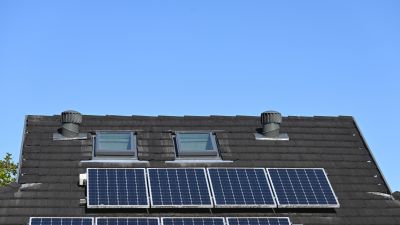Favorite Roof Vent Installation Supplies For Seamless Projects
Get the essential tools and materials trusted by homeowners and contractors for smooth and secure roof vent setups.
 Installing roof vents is a crucial aspect of maintaining proper attic ventilation and ensuring the longevity of a roofing system. The right products facilitate effective airflow, helping to regulate temperature and moisture levels within the attic space. Proper ventilation can prevent issues such as mold growth, wood rot, and ice dam formation, which can compromise roof integrity over time. When selecting products for roof vent installations, it is important to consider compatibility with your roof type, ease of installation, and durability of materials. From traditional ridge vents to more specialized options like turbine vents and static vents, there is a range of products designed to meet different architectural and functional needs.
Installing roof vents is a crucial aspect of maintaining proper attic ventilation and ensuring the longevity of a roofing system. The right products facilitate effective airflow, helping to regulate temperature and moisture levels within the attic space. Proper ventilation can prevent issues such as mold growth, wood rot, and ice dam formation, which can compromise roof integrity over time. When selecting products for roof vent installations, it is important to consider compatibility with your roof type, ease of installation, and durability of materials. From traditional ridge vents to more specialized options like turbine vents and static vents, there is a range of products designed to meet different architectural and functional needs.
Top Overall Option
Universal Roof Vent
A versatile and durable roof vent designed to fit a wide range of roof types and sizes. Made from high-quality materials, it offers reliable airflow and easy installation. Its adjustable features and weather-resistant construction make it a practical choice for many homeowners seeking effective attic ventilation.
Types of Products For Roof Vents Installations
Ridge Vents
Long, continuous vents installed along the roof ridge to provide consistent ventilation across the entire roof peak.
Soffit Vents
Vents installed under the eaves to allow fresh air to enter the attic from below.
Turbine Vents
Rotating vents powered by wind to actively draw hot air out of the attic.
Static Vents
Non-moving vents that provide passive ventilation and are often used in combination with other vent types.
Powered Attic Vents
Electric or solar-powered fans that actively ventilate the attic space.
Box Vents
Small, box-shaped vents typically installed on the roof surface to allow hot air to escape.
Gable Vents
Vents installed in the gable ends of the attic for cross ventilation.
Eave Vents
Vents located at the eaves to facilitate intake airflow.
Attic Fan Systems
Integrated fan systems that provide continuous active ventilation for larger attic spaces.
Louvered Vents
Vents with adjustable louvers that control airflow and provide weather protection.
Plywood Vents
Vents integrated into plywood panels for custom or retrofit installations.
Weatherproof Caps
Protective covers that prevent water ingress while allowing air to flow.
Popular Choices
Widely used for their seamless appearance and effective coverage across the roof ridge.
Popular for their wind-powered operation and ability to actively vent hot air.
Chosen for their ability to provide active ventilation, especially in larger or poorly ventilated attics.
Commonly paired with ridge vents for balanced intake and exhaust airflow.
Frequently selected for their ease of installation and effective cross ventilation.
Often used in combination with other vent types for passive airflow.
Popular for their adjustable features and weather resistance.
Selected for their role in facilitating intake airflow from below.
Chosen for larger spaces requiring active and continuous ventilation.
Preferred for their protective features against rain and debris while allowing airflow.
Popular for retrofit projects and small roof areas.
Commonly installed in gable ends for cross ventilation.
Choosing the appropriate roof vent products involves understanding the specific ventilation requirements of your home. Factors such as roof pitch, attic size, and climate conditions influence the best options. Many products are designed to be easy to install, often requiring minimal modifications to existing roofing structures. Durability is also key, as vents are exposed to the elements year-round, necessitating materials that resist rust, corrosion, and UV damage. Properly installed roof vents can improve air circulation, reduce energy costs, and contribute to a healthier indoor environment.
In addition to traditional vent types, there are innovative solutions that incorporate features like weather-resistant covers, adjustable louvers, and integrated screens to keep out pests and debris. Some systems are designed to work with existing roofing materials seamlessly, while others may require more extensive modifications. It is advisable to consult with roofing professionals or experienced installers to determine the most suitable products for your specific roof structure. Investing in quality roof vent products can provide long-term benefits, ensuring your attic remains well-ventilated and protected from common issues associated with poor airflow.
Key Buying Considerations
- Compatibility with your roof type and pitch to ensure proper fit and function.
- Material durability, including resistance to rust, corrosion, and UV damage.
- Vent size and airflow capacity suitable for the attic space volume.
- Ease of installation, especially if planning a DIY project.
- Weather resistance features such as protective covers or weatherproof caps.
- Design features like adjustable louvers or screens to control airflow and prevent pests.
- Compatibility with existing roofing materials and structures.
- Energy efficiency, especially for powered or solar-powered vents.
- Maintenance requirements and ease of cleaning.
- Aesthetic integration with your roof design.
- Consideration of local climate conditions to select appropriate vent types.
- Compliance with local building codes and regulations.
- Availability of warranty or manufacturer support.
- Price point relative to the features and quality offered.
- User reviews and ratings for real-world performance insights.
